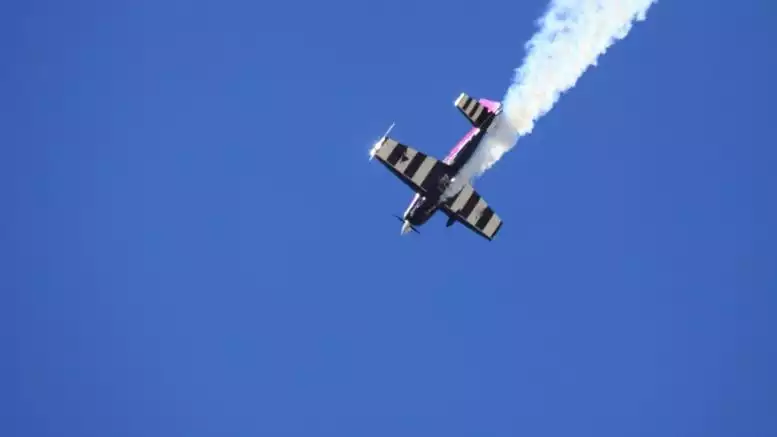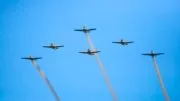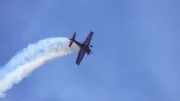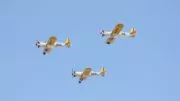How Does Airplane Altitude Affect Aerobatic Flying & Tricks?
One of the most exciting aspects of air shows is how relatively close to the ground the pilots perform their maneuvers. We normally think of “altitude” as a measure of great heights; for example, most large passenger jets tend to fly around 35,000 feet on long journeys. But when an airplane is changing directions quickly or pitching the nose up or down in fast succession, what role does airplane altitude play? Knowing what’s going on both on the outside of the aircraft, as well as in the airplane cockpit, can help you understand how the pilot is using altitude for his or her advantage in aerobatic flying.
All About Altitude
First, it’s best to have a strong grasp on what is meant by the term “altitude” in the aviation world and the ways in which it affects airplanes in general. It’s not always a matter of “how far up” an airplane is, as in the distance it is from the ground in feet or miles. Here are the different ways airplane altitude is understood in aviation:
- True Altitude: The number of feet above sea level, according to an average of sea level height, also known as mean sea level (MSL.) This is used in weather forecasts to communicate information about terrain features and how high the airplane is cleared to fly by air traffic controllers.
- Density Altitude: This refers to the pressure altitude which the airplane is experiencing, adjusted for a geographical area’s humidity, temperature, and height above sea level. It is lower in the cold and in areas close to sea level, when the airplane can generate more lift. In places with high elevations or in hot weather, density altitude increases. The airplane might struggle to perform, since lift is tougher to generate under these conditions.
- Indicated altitude: What the aircraft’s altimeter is indicating, which is its level above certain levels of pressure. Indicated altitude is regularly corrected by the pilot to adjust for pressure changes.
- Pressure Altitude: The altitude of the aircraft above an altimeter setting of 29.92 inches of mercury. It’s used to perform aircraft performance calculations, as well as flying at high altitudes.
- Absolute altitude: The most traditionally understood form of altitude; it’s the distance between the ground and where the airplane is flying, and communicated as “feet above ground level.” It’s measured by radar signals and used in weather reports.
The pilot in command (PIC) must know and adjust for all of these understandings of altitude, particularly when working with the precision demanding of aerobatic maneuvers.
Determining Airplane Altitude: Traditional Flying Vs. The Aerobatic Box
Aerobatic flying is dramatically different from other types of aviating in that it takes place in a limited three-dimensional space. Most know that any airplane which is working with air traffic controllers must stay at a certain altitude to keep it separated from other aircraft. Winds, turbulence, and the amount of other traffic all play a role in an aircraft’s prescribed flight path. Non-aerobatic pilots who are flying what’s known as VFR (visual flight rules) are usually not given a specific altitude or route by an air traffic controller and are expected to constantly watch for other aircraft.
In the specialized context of an aerobatic competition, however, arrangements are made in advance with the FAA, local air traffic controllers, air show organizers, and airports to clear the skies for the performers. Instead of a faraway air traffic controller who might not be able to keep eyes on the action, the skies are watched by a specially appointed airboss, who acts as an air traffic controller for the air show. Sometimes the airboss uses a temporary tower for the event to provide him or her with an unrestricted view. This allows the airboss to ensure that the pilot has safely left the aerobatic box or runway before giving clearance to the next performer.
When the airboss gives clearance to a pilot to perform in air show competitions, pilots are not permitted to zoom wherever they please. They must perform in a pre-determined “box” in the sky which is 1000 meters long, 1000 meters wide, and an altitude which is dictated by the division or category in which the pilot is entered. The difference between powered aircraft and gliders, as well as the level of experience of the pilot, both play a role. Points are deducted from the pilot’s performance if he or she breaks the boundaries of the box.
Airplane Altitude, Aircraft Design, and Aerobatic Maneuvers
Airplanes fly by harnessing, controlling and overcoming the pressures of the aerodynamic forces around them, from sitting on the ground to take off and flight to landing. They are specifically engineered to work with the airflow they need to not only maintain powered flight, but also to leave and safely return again. In higher altitudes, it can be more difficult to achieve lift, and airshow pilots are expected to fly closer to the ground. Therefore, a maneuver which can take place at 3000 feet above the ground is not necessarily achievable at 30,000 feet. The FAA stipulates that no aerobatic maneuvers may be executed in high-population areas to guide pilots to safe practice areas and altitudes.
Although the first airplanes were built just to get off the ground, the evolution of airplane design means that modern airplanes are now constructed with a specific mission in mind. For example, airplanes meant for cargo transport are built to withstand heavy loads and are not designed with passenger comfort in mind. Training airplanes are engineered with an eye to stability and simplicity.
Aerobatic airplanes are constructed to fly quickly and at the relatively low altitudes seen in airshows. The body, airfoils, vertical stabilizers and landing gear are all optimized for maneuverability and appropriate acceleration. They are not meant for long distance or long duration flight, and so their bodies and fuel tanks are usually lighter and smaller than those seen on conventional aircraft. The aerobatic pilots carefully study the sea level, winds, and FAA regulations when planning shows and adjusting for these factors.
Ready to Soar with Us?






